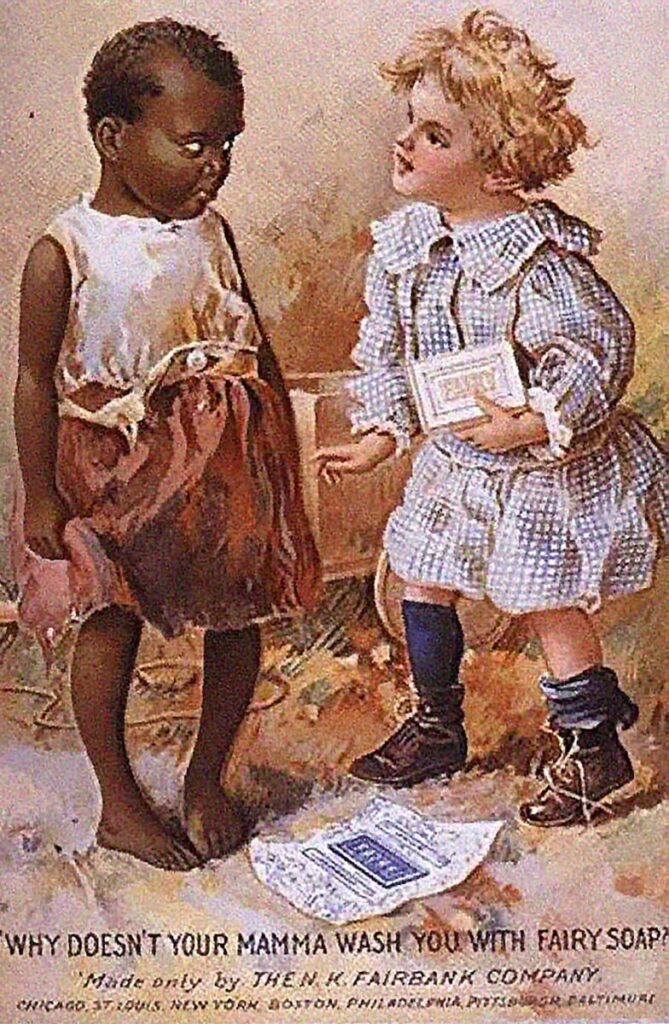“Not everything that is faced can be changed, but nothing can be changed until it is faced.” – James Baldwin. While it is true that stereotypes are part of society, it influences the perception someone has about an individual or groups of people in some cases negatively. Moreover, advertising has a long history of using stereotypes as a way to sell products at the same time it reinforces societal biases. Racial stereotypes in the media during the 19th century exposed the racist society at the time and reinforced the discrimination against minority groups. For instance, the Fairbank Bank Soap advertising in 1875 used racial African American stereotypes to sell their products while supporting the idea that white people are the superior race because of their skin color.
The Gilded Age was during the second half of the 19th century in the US. It was a period of economic growth as there was technological innovations and mass immigration. Production was on the rise, so the need for advertising was rapidly increasing. The Fairy Soap advertising card (1875) from the Fairbank Company in the U.S. was part of the popular advertising medium at the time; trade cards. Moreover, African American were “bearing the brunt of often horrific white-produced advertising” where the negative representation of them was the appeal (The Ana Educational Foundation). Trade cards reflected the cultural values at the time and so most of them were derogatory against black people. They exhibit the treatment that African American had to endure during that time (Hootman). Advertisements like this screamed racism as they highlighted the racial differences between African American people and White people by offensively representing Black people.
The Fairy Soap ad card has some coded messages in addition to the literal meaning of the written words and images. We have a white girl with blonde hair holding a soap that is facing an African American girl. Below this image there is a copy that reads “Why doesn’t your mama wash you with fairy soap? Made only by the NK Fairbank Company”. It’s clear that in order to understand the copy, the only knowledge needed is the English language. However, to understand the connotation of it we need some cultural knowledge to get the message which is the racist cultural society of the time against black people. Therefore, there is an implication that the African American girl’s skin is “dirty”, as the white-skinned girl is suggesting that her mother wash her with soap. Then, this coded message is also reinforced within the imagery. We see the African American girl barefoot, holding her raggedy dress in one of her hands while looking at the other girl. This illustration of the African American girl compared to the white girl, who’s wearing nice clothes and shoes, depicts black people as dirty and white people as clean and pure. All together, the designer tried to fix a meaning using the stereotype of black people being unclean, the card is saying that the soap is the best dirt remover in the market since it connotes the idea that it’s so good it can even “clean” dark skin.
The denigration of Black people was shown in trying to recruit more white consumers through racial stereotypes in advertising. Clearly, these kinds of advertising were targeting white people who were persuaded to buy products through the ideals of white supremacy at the expense of the African American identity. Furthermore, these ads not only served as the sale of a product, but also had a negative impact on the black community. It served as a standard for beauty and worthiness. “Gilded Age children were able to generate their individual worthiness” (Schultz). According to Stuart Hall, there is a strong power of representation of race through media where the people in power, in this case white people, created a preferred meaning through stereotyping. Black children who grew up during this time could have picked the message that they were not good enough because of how they were being represented in advertising where they aimed for a lighter skin color like white people since they were portrayed as “dirty” because of their skin color. My personal reading of the Fairy Ad soap is oppositional. Even though the advertising was created before the Civil Rights movement, when the African American community started to fight for racial equality and justice, I do not agree with the racial views and values of the ad. Not now nor back then.
Advertising during the 1800’s were trying to promote goods or services through racial stereotypes at the expense of the black community in the US. Stereotypes affected negatively African Americans by how they were represented by white people through advertisement. It is important to acknowledge historic racism through advertising and understand that it was part of the problem in building a racist American society. The advertising industry has evolved as the American values continue to change. More people continue to challenge and reject these kinds of advertisements like the Fairy Soap (1877) that no longer should represent the American values of today.
Works Cited
Barthes, R. (1964) Rhetoric of the Image. Communications, 4, 40-51.
Hootman, Jennifer. “Discrimination in Advertising Trade Cards.” Minnesota Digital Library, https://mndigital.org/projects/primary-source-sets/discrimination-advertising-trade-cards. Accessed 21 March 2024.
Schultz, Jaclyn N. “Discriminating Tastes: How Advertisements Taught Consumerism and Race to Gilded Age Youths.” UWM Digital Commons, 2013, https://dc.uwm.edu/cgi/viewcontent.cgi?article=1160&context=etd. Accessed 21 March 2024.
Stuart Hall, “Representation, Meaning and Language’” in Representation: Cultural Representations and Signifying Practices, ed. Stuart Hall (London: SAGE, 1997), 15-19.
The Ana Educational Foundation. “African Americans and Advertising · African Americans and Advertising · Race & Ethnicity in Advertising | America in the 20th Century.” Race & Ethnicity in Advertising | America in the 20th Century, https://raceandethnicity.org/exhibits/show/african-americans-and-advertis/african-americans-and-advertis. Accessed 21 March 2024.





I enjoyed reading your essay, which found be very interesting. The Ad you chose which good one to do an analysis on